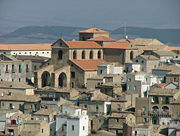
Tricarico
Encyclopedia
Tricarico is a town and comune
in the province of Matera
, Basilicata
, southern Italy
.
It is home to one of the best preserved medieval historical centres in Lucania
.

county included in the gastaldate of Salerno
. Later (9th-late 10th century) it was an Arab
ic stronghold: the terrace gardens, of Arabic origin, that are still in use today. In 968 Tricarico was conquered by Byzantine Empire
and then, in 1048, it became a Norman fortified town.
In the 15th century, there was a Jewish community.
Sights in the town include:
The archaeological area of Civita is situated outside the city. It includes a Roman
fortified center that extends for approximately 50 hectares, and consists of stone buildings with squared blocks, fortified with monumental doors. On the interior, some rooms have mosaic pavements over 2500 years old.
Also present is the Cerra del Cedro archaeological site, inhabited from as early as the 6th century by to the 3rd century BC.
Comune
In Italy, the comune is the basic administrative division, and may be properly approximated in casual speech by the English word township or municipality.-Importance and function:...
in the province of Matera
Province of Matera
The Province of Matera is a province in the Basilicata region of Italy. Its capital is the city of Matera.It has an area of 3,447 km², and a total population of 203,837 . There are 31 comunes in the province . The main comunes by population are:- External links :* **...
, Basilicata
Basilicata
Basilicata , also known as Lucania, is a region in the south of Italy, bordering on Campania to the west, Apulia to the north and east, and Calabria to the south, having one short southwestern coastline on the Tyrrhenian Sea between Campania in the northwest and Calabria in the southwest, and a...
, southern Italy
Italy
Italy , officially the Italian Republic languages]] under the European Charter for Regional or Minority Languages. In each of these, Italy's official name is as follows:;;;;;;;;), is a unitary parliamentary republic in South-Central Europe. To the north it borders France, Switzerland, Austria and...
.
It is home to one of the best preserved medieval historical centres in Lucania
Lucania
Lucania was an ancient district of southern Italy, extending from the Tyrrhenian Sea to the Gulf of Taranto. To the north it adjoined Campania, Samnium and Apulia, and to the south it was separated by a narrow isthmus from the district of Bruttium...
.

Origins
The origin of Tricarico is presently unknown. According to one hypotesis, it could derive from the Greek words treis ("three") and akros or akris ("summit", "mount", "apex"), meaning "city of the three mounts".History
Although of ancient origin, the first news documented about the town date to 849, when it was a LombardLombards
The Lombards , also referred to as Longobards, were a Germanic tribe of Scandinavian origin, who from 568 to 774 ruled a Kingdom in Italy...
county included in the gastaldate of Salerno
Salerno
Salerno is a city and comune in Campania and is the capital of the province of the same name. It is located on the Gulf of Salerno on the Tyrrhenian Sea....
. Later (9th-late 10th century) it was an Arab
Arab
Arab people, also known as Arabs , are a panethnicity primarily living in the Arab world, which is located in Western Asia and North Africa. They are identified as such on one or more of genealogical, linguistic, or cultural grounds, with tribal affiliations, and intra-tribal relationships playing...
ic stronghold: the terrace gardens, of Arabic origin, that are still in use today. In 968 Tricarico was conquered by Byzantine Empire
Byzantine Empire
The Byzantine Empire was the Eastern Roman Empire during the periods of Late Antiquity and the Middle Ages, centred on the capital of Constantinople. Known simply as the Roman Empire or Romania to its inhabitants and neighbours, the Empire was the direct continuation of the Ancient Roman State...
and then, in 1048, it became a Norman fortified town.
In the 15th century, there was a Jewish community.
Main sights
The roads and alleys of the historical center reflect themselves the Arabic quarters of the Ràbata and the Saracena.Sights in the town include:
- Cathedral of the Assunta, built by Robert GuiscardRobert GuiscardRobert d'Hauteville, known as Guiscard, Duke of Apulia and Calabria, from Latin Viscardus and Old French Viscart, often rendered the Resourceful, the Cunning, the Wily, the Fox, or the Weasel was a Norman adventurer conspicuous in the conquest of southern Italy and Sicily...
. Here, in 1383, Louis I of Anjou was crowned king of Naples. - Norman tower, standing at 27 m.
- Towers of Ràbata and Saracena.
- Ducal Palace, now home to the archaeological museum
- Sanctuary of Madonna di Fonti
The archaeological area of Civita is situated outside the city. It includes a Roman
Ancient Rome
Ancient Rome was a thriving civilization that grew on the Italian Peninsula as early as the 8th century BC. Located along the Mediterranean Sea and centered on the city of Rome, it expanded to one of the largest empires in the ancient world....
fortified center that extends for approximately 50 hectares, and consists of stone buildings with squared blocks, fortified with monumental doors. On the interior, some rooms have mosaic pavements over 2500 years old.
Also present is the Cerra del Cedro archaeological site, inhabited from as early as the 6th century by to the 3rd century BC.

